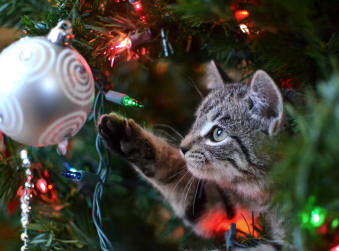 (12/2020) "Please allow me to introduce myself; I’m a man (who treats dogs and cats)." Rolling Stones
(12/2020) "Please allow me to introduce myself; I’m a man (who treats dogs and cats)." Rolling Stones
I would like to thank Mike Hillman for the opportunity to write a column pertaining to dogs and cats and Vickie Grinder for the suggestion.
I am a small animal veterinarian working in Thurmont. For 30 years, I have been treating cats and dogs. My wife is also a small animal veterinarian. Together we have 5 dogs, 3 cats, and 3 chickens.
This month I’d like to talk about household dangers to our pets especially at holiday time. Even though Halloween has passed, there may still be leftover candy, which is a big problem. Our cats and dogs cannot metabolize ingredients in chocolate which will act as a poison to them. In particular, theobromine is the problem. Symptoms of poisoning include vomiting, diarrhea, high heart rate, agitation, tremors, and seizures. It all depends on the type of chocolate ingested, the amount, and the size of the pet. Dark chocolate and cocoa are more concentrated forms and
therefore more dangerous. Milk chocolate is less toxic. No chocolate should ever be given to a pet. Furthermore, any access to chocolate, candy, or cocoa needs to be prevented because pets will seek it out. In addition, any candy or other products like sugar-free gum and some peanut butters with the artificial sweetener Xylitol are poisonous to pets. Ingestion can cause vomiting, low blood sugar, lethargy, liver damage, drunkenness, temors, and seizures.
Thanksgiving is approaching as I write this. Turkey bones and all real bones are hazardous to our pets. They are too hard for their teeth. That goes for antlers and chew hooves too. Teeth will crack and break. Pieces of bones can get stuck in the mouth, the esophagus, the stomach, or the intestines. I have seen all of these scenarios occur. Even soft bones can cause gastrointestinal symptoms like vomiting, diarrhea, or even constipation (they are not digested.)
Better ideas for chewing are edible and digestible Nylabones and Greenies. Kongs are good, and peanut butter (don’t forget to check for no Xylitol added) or squeeze cheese can be placed inside of them.
The major holiday for a lot of potential safety hazards to pets is Christmas. Trees (artificial or real) and tree water present danger if ingested. Light strands because of their bulbs and electricity are a potential hazard. Ornaments and decorations are concerning if ingested. Tinsel and other stringy decorations can become linear foreign bodies in the stomach or intestinal tract if ingested. This is a big problem for cats who like to ingest string-type objects like dental floss and sewing thread (and the attached needle).
There is a long list of toxic plants that can cause poisoning. I will provide the list of them next month. However, Christmas plants to watch out for are poinsettias and mistletoe.
There is no end to the possibilities of what our pets manage to fit in their mouths and swallow. I have removed balls, socks, underwear, sewing needles, carpet strands, kids toys of many varieties (i.e. Nerf darts, many hairbands (out of 1 dog), pet toys, and coins.
Every year a veterinary news magazine has a contest for the strangest objects removed from any animal. This has included dogs and cats, but also pet frogs, snakes, lizards. I actually was able to get an honorable mention for removing a diamond engagement ring from a small dog’s stomach. It was snatched off the owner’s finger when the dog aggressively took food out of the owner’s hand.
Please take preventive action to keep your pets safe year round but especially around the holidays. Remember to puppy proof and kitten proof your house just as you would babyproof it.
If you have any question about a foreign body or toxic ingestion, please contact your veterinarian or call a veterinary poison control center. These centers are dedicated to pets and their parents. They are fee-based in order to be able to provide their service to owners and veterinarians. The number for the ASPCA Animal Poison Control Center is 888-426-4435. The Pet Poison Helpline is 800-213-6680.